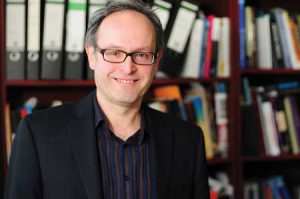
Researching the history of modern surgery
By Katherine Gombay
After G. Frank Lydston implanted a testicle from a recently deceased 18-year-old man into his own scrotum, the American surgeon reported feeling distinctly reinvigorated. This was in 1914, when the fashion for testicular transplants was reaching its peak. This is just one of the episodes that Thomas Schlich, from the Department of Social Studies of Medicine, details in his recent book, Origins of Organ Transplantation: Surgery and Laboratory Science, 1880-1930.
Doctors in the early part of the twentieth century thought that testicular transplants might help those who suffered from impotence or who had lost testicles to disease or accidents. Many also believed that these transplants had a particularly rejuvenating effect, linking the testes with force and energy.
Although some of the testicles which were transplanted came from humans, others were from sources as varied as monkeys and goats. And though, for the doctors who did them, such transplants were definitely a business proposition, it wasn’t only the upper classes that reaped the benefits. Schlich writes that a surgeon in 1921 “…implanted the testicles of a twenty-year old into a ‘run-down’ prematurely aged labourer in order to ‘generally freshen him up a bit’.”
Surgical intervention
While the practice of testicular transplants lasted for just the first part of the twentieth century, the idea of cutting out diseased or damaged body parts and replacing them with healthy ones lies at the heart of modern surgery.
“It’s an idea that’s really quite peculiar…to open up a body and have the expectation that you solve a problem by doing so. If you look at history, 200 hundred years ago nobody thought that this would make a difference,” says Schlich.
Moreover, Schlich asserts that this idea, apart from a short 50-year period in China, is particular to modern Western culture.
It was around 1800 that a revolutionary shift took place in Western medicine. Until this point, physicians had tried to heal their patients by rebalancing the humours, which were associated with bodily fluids like bile and phlegm, and were influenced by the patients’ ways of living – what they ate and drank, how often they had sex, but, also by the weather and the winds. Physicians relied on practices like bloodletting or recommending particular diets (such as hot, dry foods for bodies deemed too cold and wet) in order to right the imbalances.
When they needed to, they also called on surgeons to deal with broken bones and various problems, such as skin tumors, occurring at the body surface. Surgeons charged less for their services than did university-trained physicians, and hence tended to be called upon more frequently. Until about 1800, they learned their trade through a two- to three-year apprenticeship, and were organized in guilds, which might also include barbers, apothecaries and even grocers.
But, starting at about the time of the French Revolution, everthing started to change. In France, the medical schools, which had been closed down for some years, were reopened when people saw that there was a need for trained medical practitioners. For the first time, surgeons also started receiving medical training.
Turning the focus inward
At the same time, the traditional medical view of the surgeons, who were accustomed to dealing with problems in a localized way, started to be applied not only to the surface of the body but to its interior as well. Rather than conceiving of the body as being in balance with nature, it came to be seen as a collection of parts that could be treated separately. Schlich explains, “If you think disease is all about balance, it doesn’t make much sense to put in a new kidney. But the idea of things like skin tumors was now applied to the inside of the body, so you could have tumors in your stomach or an inflammation of your kidney and that would explain the disease.”
Along with this major conceptual shift, and a new style of professional training for surgeons, there were also improvements in surgical techniques, thanks to the development of modern anesthesia and better methods for preventing post-operative infections. Schlich is busy puzzling how all these factors came together. “It all had to happen simultaneously. In writing about surgery I’m forced to include the material and practical dimension of things. I have to look at what the interaction was between the knife and the issue and that’s what I find fascinating.”
